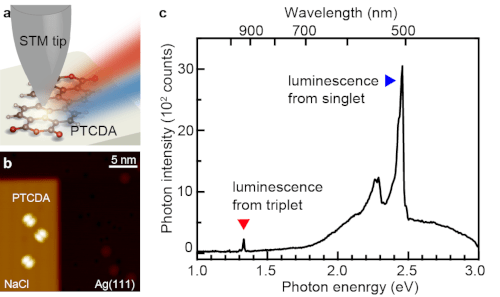TOKYO, June 10, 2019 — Scientists from RIKEN and the University of California, San Diego, in collaboration with international partners, have demonstrated a new way to manipulate the excitons that are essential to the transport of electrons within OLEDs. They showed that the electron transport process accompanying exciton formation in OLEDs can be controlled by manipulating an electron spin inside a molecule. The discovery could significantly reduce the amount of energy that OLEDs require.

Schematic image of the measurement; (b) STM image of PTCDA adsorbed on NaCl grown on Ag(111); (c) luminescence spectrum. Courtesy of RIKEN.
Typically, the excitons in OLEDs occur in two patterns, triplets and singlets. Singlets need more energy, and although they can be converted into triplets, additional energy is required to create them in the first place. The researchers found a way to lower the voltage in OLEDs so that only triplets are formed.
To better understand the physics behind the process of exciton creation, the researchers made precise, single-molecule electroluminescence measurements using a scanning tunneling microscope combined with an optical detection system. They prepared a model system based on an isolated molecule of an organic semiconductor called 3,4,9,10-perylenetetracarboxylic dianhydride (PTCDA), adsorbed on a metal-supported, ultrathin insulating film.
‘We believe that these findings could become a general working principle for novel OLEDs with low operating voltage,’ said professor Yousoo Kim.
First, they delivered a negative charge to the molecule. Then, using the current from a scanning tunneling microscope, they induced luminescence in the molecule and monitored which type of exciton was created based on the emission spectrum. The measurements showed that at low voltage, only triplets were formed. Theoretical calculations confirmed the experimental results.
“We believe that we were able to do this thanks to a previously unknown mechanism, where electrons are selectively removed from the charged molecule depending on their spin state,” said researcher Kensuke Kimura. The team’s findings could become the basis for realizing a new type of OLED with lower operating voltage.
Scientists from the University of Tokyo and the Institute for Molecular Science also contributed to the work. The research was published in Nature (https://doi.org/10.1038/s41586-019-1284-2).